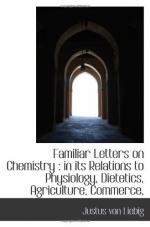In cyanuric acid, hydrated cyanic acid, and cyamelide, we have three such isomeric compounds.
Cyanuric acid is crystalline, soluble in water, and capable of forming salts with metallic oxides.
Hydrated cyanic acid is a volatile and highly blistering fluid, which cannot be brought into contact with water without being instantaneously decomposed.
Cyamelide is a white substance very like porcelain, absolutely insoluble in water.
Now if we place the first,—cyanuric acid,—in a vessel hermetically sealed, and apply a high degree of heat, it is converted by its influence into hydrated cyanic acid; and, then, if this is kept for some time at the common temperature, it passes into cyamelide, no other element being present. And, again inversely, cyamelide can be converted into cyanuric acid and hydrated cyanic acid.
We have three other bodies which pass through similar changes, in aldehyde, metaldehyde, and etaldehyde; and, again two, in urea and cyanuret of ammonia. Further, 100 parts of aldehyde hydrated butyric acid and acetic ether contain the same elements in the same proportion. Thus one substance may be converted into another without addition or subtraction, and without the participation of any foreign bodies in the change.
The doctrine that matter is not infinitely divisible, but on the contrary, consists of atoms incapable of further division, alone furnishes us with a satisfactory explanation of these phenomena. In chemical combinations, the ultimate atoms of bodies do not penetrate each other, they are only arranged side by side in a certain order, and the properties of the compound depend entirely upon this order. If they are made to change their place—their mode of arrangement—by an impulse from without, they combine again in a different manner, and another compound is formed with totally different properties. We may suppose that one atom combines with one atom of another element to form a compound atom, while in other bodies two and two, four and four, eight and eight, are united; so that in all such compounds the amount per cent. of the elements is absolutely equal; and yet their physical and chemical properties must be totally different, the constitution of each atom being peculiar, in one body consisting of two, in another of four, in a third of eight, and in a fourth of sixteen simple atoms.
The discovery of these facts immediately led to many most beautiful and interesting results; they furnished us with a satisfactory explanation of observations which were before veiled in mystery,—a key to many of Nature’s most curious recesses.
Again; solid bodies, whether simple or compound, are capable of existing in two states, which are known by the terms amorphous and crystalline.
When matter is passing from a gaseous or liquid state slowly into a solid, an incessant motion is observed, as if the molecules were minute magnets; they are seen to repel each other in one direction, and to attract and cohere together in another, and in the end become arranged into a regular form, which under equal circumstances is always the same for any given kind of matter; that is, crystals are formed.




